CHRISTIE’S SALE 2713,
JUNE, NEW YORK, 2013
SOLD FOR $2,251,750.00 USD

“THE PALMER”
This noteable acquistion was consigned to Christies by YE OLDE TIMEKEEPERS and quickly became one of the most important timepiece discoveries in the past decade in complicated pocket watches to hit the global market.
The present Grand Complication rewrites history by anticipating it by a decade making the present watch number 97’912 become the first ever publicly seen or described Grand Complication made by the Geneva firm, which is coming for the first time ever to the market.It is probably the most complete and crispest example of all Grand Complications known today; furthermore, it is the only example known to have been cased in pink gold whereas all the sequent pieces were cased in the more typical yellow gold accordingto the1910′, 20′ and 30’s style. The present pocket watch is an Exceptionally Fine and Highly Important 18kt Pink gold Openface Minute Repeating Perpetual Calendar Split-Second Chronograph Clockwatch Grande and Petite Sonnerie, Moonphases, and Accompanied by Original Certificate, Invoice dated 1900, and Presentation Boc, sold to Stephen Palmer.
Patek Philippe is broadly acknowledged as the gold standard in crafting the world’s finest and most complicated watches today. This reputation is based on a nearly 175 year long tradition of serving the world’s most demanding collectors and patrons of fine watchmaking. Most notably, this reputation has been further propelled by notable collectors such as James W. Packard, the automobile manufacturer from Ohio, and Henry Graves Jr., the distinguished private banker from New York. The tradition of ordering complicated pieces from Patek Philippe continued after the War World II with collectors such as Esmond Bradley Martin into the second half of the 20th century. Until the appearance of the present watch it was broadly accepted that Patek Philippe did not make its first Grand Complication until about 1910 and that the second ever made example was reserved shortly before World War I for James W. Packard, watch number 174’129, in 1916. The discovery of this Grand Complication is a spectacular addition to scholarship surrounding Patek Philippe and Grand Complications in general.
The watch is monogrammed SSP and the original certificate, still present to this day, confirms that the engraved monogram was indeed applied at Patek Philippe’s own Geneva workshops. It is only thanks to the original invoice that the world today knows who the owner of the SPP monogram in fact is: Stephen Squires Palmer. Stephen S. Palmer was one of America’s most prominent and successful businessmen at the turn of the 20th century and can be considered in the same league as a Packard or Graves to have been a distinguished client of Patek Philippe for such an historical timepiece.
SOTHEBYS SALE LOT 198,
MAY, NEW YORK, 2014
SOLD FOR $1,055,000.00 USD

“EYE OF TIME”
This noteable acquistion was consigned to Sothebys by YE OLDE TIMEKEEPERS and quickly became one of the most important timepiece discoveries in the past decade in Modern Art Form watches to hit the global market.
The present piece is made by Salvador DalÌ, 1904 – 1989 entitled the “THE EYE OF TIME”. Inscribed DalÌ (on the dial) This extremely rare timepiece is made from Platinum, diamond, ruby and blue enamel brooch with a mechanical Movado watch movement. The Length is 2 3/4 in.; 7 cm and it was Conceived in 1949 and executed before 1951 by the jewelers Alemany & Ertman, New York. The Provenance of this piece originated with Alemany & Ertman, New York, and then was preserved in Private Collection in Italy when acquired in the early 1950s. YE OLDE TIMEKEEPERS Acquired this piece from the above private collection in 2013.
The crowning glory of this ensemble of 39 jewels, which DalÌ created between 1941 and 1970, is undoubtedly The Eye of Time. Originally conceived in 1949 as a gift for his wife Gala, The Eye of Time plays on the themes and myths that obsessed the artistís thoughts and incorporates two of the most iconic DalÌ symbols: the eye and the clock. Surrounded by rows of pavÈ-set diamonds and set in platinum with a cabochon ruby, the eye’s pupil is made of three shades of blue enamel and brilliantly doubles as the face of a working Movado movement. DalÌ entrusted the making of his jewels to the illustrious New York jewelers Alemany and Ertman, who made a limited number of pieces after the artistís original designs and under his strict observation. There are three known examples of The Eye of Time, including one in a prominent European Royal collection, another which was formerly in the collection of The Owen Cheatham Foundation and which is now on permanent display at the FundaciÛ Gala-Salvador DalÌ in Figueres, and the present work. “To history, [the DalÌ jewels] will prove that objects of pure beauty, without utility but executed marvelously, were appreciated
in a time when the primary emphasis appeared to be upon the utilitarian and the material. [They] were not conceived to rest soullessly in steel vaults. They were created to please the eye, uplift the spirit, stir the imagination and express convictions.” óSalvador DalÌ A self-styled ìRenaissance Man,î Salvador DalÌís talents stretched far beyond his extraordinary gifts as a painter and draughtsman; his expansive artistic repertoire also included film, sculpture, poetry, photography and theatre, often in collaboration with other artists. DalÌís exquisite jewels, however, capture the attention and imagination like nothing else. A triumph of technical virtuosity and spectacular visual pyrotechnics, they embody the “love of everything that is gilded and excessive” of the man whose name AndrÈ Breton turned into the anagram “Avida Dollars.îThis example has been featured in numerous literature:
Literature Linda Livingston, ed., DalÌ, A Study of his Art-in-Jewels, The Collection of the Owen Cheatham Foundation, Greenwich, 1959, p. 46, illustration in color of another example on the cover & fig. XIX RamÛn GÛmez de la Serna, DalÌ, New York, 1979, illustration of another example p. 234 & in color p. 125 Robert Descharnes, Salvador DalÌ. The Work, The Man, New York, 1984, illustration in color of another examplep. 352 Barbara Cartlidge, Twentieth-Century Jewelry, New York, 1985, no. 93, illustration in color of another example on the cover & p. 72 Robert Descharnes & Gilles Neret, Salvador DalÌ 1904-1989, The Paintings: 1904-1946, vol.I, Cologne, 1994, no. 762, illustration in color of another example p. 338 Center for Dalinian Studies, Gala-Salvador DalÌ Foundation, ed., DalÌ, Jewels-Joyas, The Collection of the Gala-Salvador DalÌ Foundation, Figueres, 2001, illustration in color of another example pp. 37-39 Center for Dalinian Studies, Gala-Salvador DalÌ Foundation, ed., DalÌ Jewels, The Collection of the Gala-Salvador DalÌ Foundation, Barcelona, 2011, no. 7, illustration in color of another example on the cover & pp. 10 & 47
CHRISTIE’S SALE LOT 42
DECEMBER, NEW YORK, 2016
SOLD FOR $487,500.00 USD
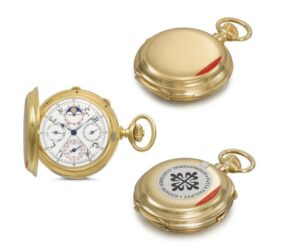
“THE ETHAN ALLEN”
This noteable acquistion was consigned to CHRISTIE’S by YE OLDE TIMEKEEPERS and quickly became one of the most important timepiece discoveries in the past decade in Pocket watches to hit the global market.
The discovery of a previously unknown, unique, specially commissioned Patek Philippe Grand Complication watch is today an almost unheard of landmark event, creating a frisson of excitement amongst both watch collectors and those who pursue the very best world-class works of art. YE OLDE TIMEKEEPERS is proud to have been responsible for making history by offering for the first time ever to the market, Grand Complication originally made to the order Carrie Belle Carter Allen of Louisiana for her husband Dr. Ethan Allen, very few watches of this importance have such a fully-known history and provenance while even fewer were tailor-made to the buyerís specifications or so completely personalized. As such, it joins the ranks of the legendary Patek Philippe watches made in the early 20th century for the great American millionaire industrialists including James Ward Packard and Henry Graves Jr.
Not only is the present watch one of Patek Philippeís most extraordinary technical triumphs, it is also very early in the production of the companyís Grand Complication watches, furthermore it is the only known Patek Philippe watch with these complications to have a full hunter case. The year 1904 was a very significant one in the Southern U.S. It was the year of the Louisiana Purchase Exposition in Forest Park ñ the ìSt. Louis Worldís Fairî which lasted from 30th April until 1st December 1904. Patek Philippe were exhibitors and also participated on the jury. It was in all probability at the St. Louis fair that Mrs. Allen commissioned this watch directly from Patek Philippe. The rare opportunity of coming face to face with the companyís representatives from Switzerland would certainly account for the sheer uniqueness and number of bespoke elements created for this watch, all adding to what was already one of the most complicated and expensive watches that Patek Philippe had made up to that date. To the best of our knowledge there are only five known watches made by Patek Philippe where the dials have letters instead of numerals. They are either by or attributable to Pierre Reymond, one of the best dial makers of his time in Switzerland whom Patek Philippe commissioned to make the dials of some of their most outstanding watches.
The present exceptional Grand Complication watch has some artistically unique and technically advanced features: Hunter case ñ to the best of our knowledge, this is the only watch with these particular horological complications to be fitted with a hunter case. The Extract from the Patek Philippe Archives specifically mentions the hunter case and describes it as ìLouis XVI styleî one of the most expensive styles. The interior of the front cover is adorned with an engraved portrait of Carrie Belle Allen herself. This kind of highly detailed, almost photographic style of engraving is called ìtaille douceî. Dial ñ The totally unique specially commissioned hand-made enamel dial is a true masterpiece of the enamellist’s art. Confirmed by the Extract from the Archives, as ìenamel dial, hour markers in capital lettersî. Very few makers were skilled enough to make a dial of such complexity and artistry. This one-off work of art is most likely to be the work of Pierre Reymond who was responsible for many of Patek Philippeís finest and most complicated dials. The numerals spelling the name C. B. C. ALLEN are furthermore very cleverly and
cleverly and beautifully designed as ìrootsî, thought to represent the cinchona root in reference to Dr. Allenís work as herbalist and practitioner of homeopathy. Another interesting feature of the dial is that the days of the week are in Latin. This may have had some personal significance for the Allens and to the best of our knowledge is unique on a Patek Philippe watch. Movement ñ Most of Patek Philippeís highly complicated movements and special projects were constructed using ebauches supplied by the legendary maker Victorin Piguet & Cie. The present watch is highly unusual and possibly unique in having the name of the owner engraved upon the movement itself in addition to the Patek Philippe signature. The balance wheel and escapement is very highly finished with gold and platinum adjustment screws. YE OLDE TIMEKEEPERS is proud to have offered the present watch with Christies as a one-of-a kind discovery for the history of two creative individuals at the turn of the century America, for the history of
Patek Philippe, and indeed for the history of unique horological masterpieces.
SOTHEBYS SALE N08722
LOT 386
DECEMBER, NEW YORK, 2011
SOLD FOR $482,500.00 USD
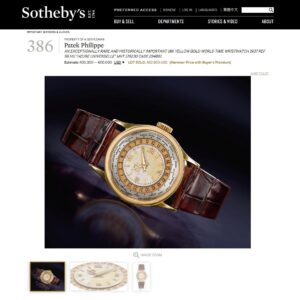
“PROTOTYPE WORLDTIME”
This noteable acquistion was consigned to Sothebys by YE OLDE TIMEKEEPERS and quickly became one of the most important timepiece discoveries in the past decade in Vintage Wristwatches to hit the global market.
Previously unknown to the market, this Ref. 96 HU World Time wristwatch redefined the current scholarship on Patek Philippe world time wristwatches from the late 1930s. As one of the first world time watches ever made by Louis Cottier, the recently discovered timepiece is one of the earliest and rarest world time watches known to exist. Preserved in unrestored condition, this Ref. 96 HU is the ultimate expression of Patek Philippe’s forward-looking commitment to horological innovation. Produced two decades before the dawn of the jet-age, early world time wristwatches are the opening chapter of 20th century complicated wristwatch production. The presently offered Ref. 96 HU is among the very first examples from this exciting period in the history of watchmaking.
Of At least three examples known to exist, only one of those has come to auction. That piece was made in 1937 with movement number 811161 and case number 294862, the Ref. 515. The presently offered 96 HU has a case number 294861, one digit earlier the 515 HU, and it was also sold to a client in 1937, It is quite possible that this 96 HU is one of the first two Patek Philippe World Time watches ever sold and the first world time in a Calatrava case ever to be sold. The other known version of the 96 HU, with a later case number 294923, was not sold until one year later than the present example,in 1938. Both examples, possibly prototype designs, feature dials without the Patek Philippe signature. The present example is distinguished by its salmon 24-hour dial and the bullet-shaped indexes. The presently offered lot for the 96 HU has a larger 12”’ movement. These early 12” movements were made from older LeCoultre ebauches that were likely originally destined for Gondolo & Labouriau, The remaining movements were kept behind at Patek Philippe hidden away for decades before they were called to duty. Complete with gold wheels, moustache lever escapements, and swan-neck regulators, these movements were the perfect size and quality for Cottier to develop his novel world time concept.
PHILLIPS SALE 3, LOT 1103
November, Hong Kong, 2011
SOLD FOR $239,382.00 USD
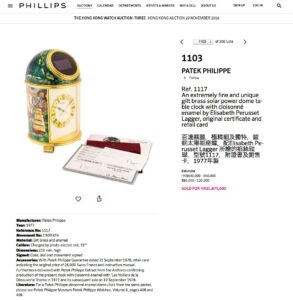
“THE VASCO DE GAMMA”
This noteable acquistion was consigned to Philips by YE OLDE TIMEKEEPERS and was one of the most important solar clocks to hit the global market in the past three years.
Patek Philippe cloisonnÈ enamel dome table clocks have increased in value and collectability tremendously in the last few years. Each piece is unique with varying themes and only a very small select number of artists are qualified to work on such objects that have curves to the panels where the enamel lies. The enamel of the present dome clock was created by the famous artist Elisabeth Perusset Lagger in 1977. The theme of this dome clock takes inspiration from the famous voyage of Vasco De Gamma when he successfully sailed from Portugal to India via Africa, which enabled Portugal to become dominant world power in the 15th and 16th centuries.
This new route allowed Portugal to bypass the treacherous Mediterranean Sea. The enamel depicts his sail boat, the African nation alongside a compass, fishes, sea, lightening and angels blowing wind, helping De Gama with his voyage. This clock has been kept hidden away from the world, until YE OLDE TIMEKEEPERS supplied it to Philipps and is in excellent overall condition with very brightly coloured enamel panels. The clock, in additional to the certificate and retail card, still retains its original sticker on the bottom of the case which is highly unusual to be sold alongside with.
PHILLIPS SALE 1, LOT 2778
December, Hong Kong, 2015
SOLD FOR $235,545.00 USD
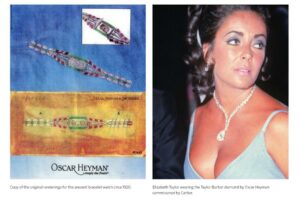
“THE EGYPTIAN REVIVAL”
This noteable acquistion was consigned to Philips by YE OLDE TIMEKEEPERS and was one of the most important Gemstone timepieces to hit the global market and is currently on display in the Audemars Piguet Museum Private Exhibit .
This Oscar Heyman bracelet watch must be considered one of their most important bracelet watch creations. It can be best described as a superlative masterpiece watch of the 1920s Art Deco period, merging the finest craftsmanship with one of the most prestigious watchmakers of the period. Oscar Heyman & Bros., better known in the industry as the jewelerís jeweler, rose to prominence in the 1920s after Oscar and his brother, Nathan Heyman, immigrated to the United States from Latvia in 1906. Having previously apprenticed at their uncleís FabergÈ workshop, the brothers were well equipped to work in platinum, a relatively new metal at the time, and distinguished them from contemporaries, and quickly garnered the attention of prestigious jewelers. The brothers eventually worked as bench jewelers for Cartier, Van Cleef & Arpels, Shreve, and J.E Caldwell among others. In fact, Oscar Heyman & Bros. was the first
American workshop to master Van Cleef & Arpelís iconic mystery setting.They were also commissioned by Cartier in the late 1960s to design and set the infamous Taylor Burton diamond, given to Elizabeth Taylor. The movement of the present watch is manufactured and signed by Audemars Piguet who is known to have only produced 3 tutti frutti watches until this discovery of the fourth,This bracelet watch was designed by Oscar Heyman in the early 1920s in the Art Deco style of ëTutti Fruttií. ëTutti Fruttií jewelry was inspired by the design, colour and setting of Indian gem-set jewelry and Egyptian Revival. Cartier and other leading jewelry designers took their own approaches to the the world of ancient Egypts, which was gripping society in the early 1920s. Egyptomania of Art Deco materialized in buildings, decorations and elegance. Tthe discovery of Tutankhamun in 1922, generated even further excitement in society and helped secure the Art Deco period and the love for Egyptian revival through magnificent jewelry creations, such as the present Oscar Heyman bracelet watch. The design of the present timepiece is distinguished by the present braceletís brilliant diamonds, carved rubies in the form of scarabs, baguette emeralds and unique claw setting. The hinged cover is further inspired by the Maharajaís jewels, with a central marquise diamond flanked by two brilliant cut diamonds on either side and further surrounded by two rows of brilliant cut diamonds.
CHRISTIE’S SALE 3269
LOT 2741
November, Hong Kong, 2013
SOLD FOR $189,529.00 USD

“THE MASTERPIECE”
This noteable acquistion was consigned to CHRISTIES by YE OLDE TIMEKEEPERS and was one of the most important Gemstone timepieces to hit the global market.
The present watch represents a true masterpiece in collaboration of these three great firms. The term masterpiece is applied to a single piece of master craftsmanship.Upon combining their skill, technique and superior levels of manufacture, Vacheron Constantin, Verger FrËres and Ostertag produced this stunning necklace; a truly one of a kind piece of art, jewelry and horology.Founded in 1755 Vacheron Constantin stands as the oldest watch manufacturing company in Geneva. Over the years of its uninterrupted production Vacheron Constantin remained dedicated to being at the forefront of technical innovations and design. The name “Verger FrËres”, a synonym for watches, clocks and jewelery of unparalleled creativity and design, inevitably evokes the ever popular Art Deco period. The celebrated house was founded in Paris in 1872 by the talented jeweler and watchmaker Ferdinand Verger (1851-1928). Verger FrËres creations are distinguished by their innovative use of precious materials and the outstanding workmanship of their watches,
Although often associated with.Verger’s partnership with Vacheron & Constantin started as early as 1879 when Ferdinand became the agent of the Geneva firm in Paris. The combination of the watch manufacturer’s technical know-how and Verger’s outstanding creativity and skillfulness resulted in the creation of extraordinary watches and clocks, such as the present timepieceh. To add a further level of manufacturing provenance the present necklace remains a collaboration of three. The French jeweler Ostertag was founded in the 1920’s,located in Paris, During the 1920s and 1930s, Ostertag’s creations were world renown rivaling the creations of the celebrated jewelry houses of Cartier, Van Cleef & Arpels and Boucheron. They were especially well-known for their jewelery and objets d’art based on Asian and Indian designs. Emeralds, Carved rubies, and sapphires often imported from all over world were interspersed with diamonds and arranged into impressive unique pieces crafted at the highest known level of their day
and frequently purchased by the world’s elite clientele which ranged from empresses, kings, dukes and celebrities. Several renowned Parisian jewelers, were asked to commission masterpieces in collaboration with other world renown jewelry and timepiece houses of their time, one of which is featured here. Due to the Second World War, wherein Ostertag closed their doors never to open again, few pieces remain, leaving few pieces today.This masterpiece represents a true ingenious collaboration by three of the most respected names in the fields of horology, jewelry and design.
SOTHEBY’S SALE 0389
LOT 2091
OCTOBER, HONG KONG, 2012
SOLD FOR $165,10700 USD

“THE PORT OF AMSTERDAM”
This noteable acquistion was consigned to SOTHEBYS by
YE OLDE TIMEKEEPERS and was one of the most important Pocket watch timepieces to hit the global market.
Painted by the famed and highly skilled enamellist Pellarin Leroy, this extraordinary piece features a miniature version of the 1674 oil on canvas painting ëThe Port of Amsterdamíby Ludolf Backhuyzen. The original painting is on display at the Kunsthistorisches Museum in Vienna, Austria. Painted enamel scenes of this type are usually copied by hand from a larger image or created as a unique piece of artwork as a miniature by the enameller.
Patek Philippe have always prided themselves on using only the most highly skilled miniature enamellers to create the unique scenes featured on their pocket watches. This is very possibly carried over from a family tradition as the parents of Charles and Jean Stern, the dial makers of Stern Freres that took controlling interest in Patek Philippe & Co in 1932, were themselves both enamellers. The Stern family remains in control of the company and continue this tradition of using exceptional enamel artistry in contemporary watches .
Due to the repeated heating and cooling required, not only must the artist take into consideration changes in colour due to the heat but potential cracks caused by re-heating. As each miniature can take a year to create and requires such a meticulous process, this artform today is regarded as one of the rarest and most difficult skills to master in the industry.
PHILLIPS SALE 2,
LOT 354
May, Hong Kong, 2016
SOLD FOR $158,784.00 USD
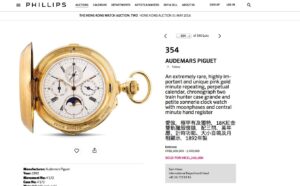
“THE AUDEMARS PIGUET GRAND COMPLICATION”
This noteable acquistion was consigned to PHILLIPS by YE OLDE TIMEKEEPERS and was one of the most important Pocket watch timepieces discoveries to hit the global market.
Previously unrecorded anywhere in literature, YE OLDE TIMEKEEPERS was delighted to present with PHILLIPS this rare timepiece discovery of an Audemars Piguet Grande Complication clock watch. Fitted with no fewer than 11 complications, the present watch is one of the most complicated Audemars Piguet known to exist and is one of the earliest known examples to have been manufactured. Every Grande Complication made by the firm during the late 19th century was a unique piece. Due to the time it required to create each watch, there were always variations in their production. This watch is one of three petite and grand sonnerie watches with comparable complications manufactured by Audemars Piguet. The Clock Watch was invented hundreds and hundreds of years ago. The earliest known example is dated at around 1551 and was made by French maker Jacques de la Garde. The earliest English clock watches began to appear from around 1600. The earliest known watches usually had striking trains as they originated directly from spring driven table clocks.
The grande and petite sonnerie mechanism was developed in the late 18th century. The petite mechanism strikes the quarter and the hour in passing. The grande mechanism strikes both quarter and hour at each quarter. It was Breguet who added the minute repeating mechanism to the grande and petite sonnerie clock watch in around 1801. Following the French revolution, the Swiss produced many examples of the grande and petite sonnerie clock watch for export and this really laid the foundation for very complication watches in the 19th century. It was this development in watchmaking in Switzerland that really gave the Swiss the international reputation as master watchmakers. The production of clock watches stopped in the 1st quarter in the 20th century due to the extremely high costs and hundreds of hours of labour to manufacture them. This Audemars Piguet grande complication is an exceptional example with the highest quality five-part hinge case that is extremely crisp and in many ways appears to be quite unused. The case hinges are extremely tight and the case closes extremely well. The eleven complications that make up the mechanism make this clock watch one of the most important Audemars Piguet watches to have appeared on the market in recent years.
SOTHEBY’S SALE 8848,
LOT 88
June, Hong Kong, 2014
SOLD FOR $122,500.00 USD

“THE IMPERIAL GUARD”
This noteable acquistion was consigned to SOTHEBYS by
YE OLDE TIMEKEEPERS and was one of the most important Pocket watch timepieces to hit the global market.
Known for her enamels depicting scenes inspired by Romantic artists, Helene Mercier was a famous enamellist artist for Patek Philippe from the 1970s through the early 1990s. The scene depicted on the presently offered lot is inspired by the painting
The Imperial Guard was a group of elite soldiers that were under the direct command of Napoleon and the unit acted as his personal body guard and escort. Napoleon respected and admired their lavish uniforms and often wore their uniform out of respect for their valor and style.
“The Horse Mounted Officer of the Imperial Guard” by Theodore Gericault (1791-1824) and can now be seen at the Louvre. Mercier brilliantly reinterprets the Gericault masterpiece on this watch in miniature.
CHRISTIES, LOT 95
June, New York, 95
PRICE ON REQUEST
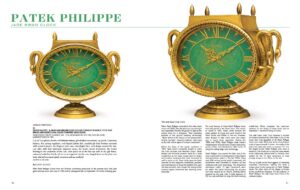
“THE JADE SWAN”
This noteable acquistion was consigned to CHRISTIES by YE OLDE TIMEKEEPERS and was one of the most important clocks to hit the global market. and timepiece discovery.
The Jade Swan Clock features a number of unique characteristics that make it one of the rarest and most beautiful of all the Patek Philippe clocks ever made. Most solar dome clocks feature a dial of approximately 3 inches- the width of the dial of this Jade Solar clock is massive 7.5″. It is the largest known PatekPhilippe solar clock in existence. The hands are so long that they needed t be elaborately skeletonized to minimize their weight for the ‘7 ligne movement to have enough torque to turn them on the dial. The use of jade on the dial suggests an extremely important commission, making this clock a unique piece in the production of Patek philippe clocks. No other clock of this design is known to the world from literature. For the collector of Patek Philippe, the Jade Swan Solar Clock is the ultimate trophy.
When Patek Philippe marketed its first solar clocks in the mid 1950s, they did what was once thought was impossible: harness the power of light as the motive force for a timepiece. Their marketing boasted of this ground breaking technology, “Never before in history of the measurement of time, has light-neutral or artificial been used as the sole motive agent of a clock mechanism”. The most famous of these Patek Philippe clocks from this period is the dome clock. First shown to the world in 1955, these clocks became the status symbol of luxury and were found in the finest homes and offices of the era, second only to that of the recently discovered Jade Swan solar clock.
CHRISTIES, SALE 3269,
LOT 2411
November, Hong Kong, 2013
SOLD FOR $83,230.00 USD

“THE MINUTE REPEATER”
This noteable acquistion was consigned to CHRISTIES by YE OLDE TIMEKEEPERS and was one of the most important timepieces to hit the global pocket watch market.
The present watch broke numerous record pricing within its timepiece genre as one of the earliest most complete minute repeaters to go to sale in perfect condition. The pocketwatch was made for Shreve ,Crump & Low and manufactured in 1911.
PHILLIPS SALE 1,
LOT 275
December, Hong Kong, 2015
SOLD FOR $76,823.00 USD
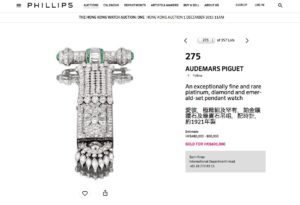
“THE CONCEALED CROWN”
This noteable acquistion was consigned to PHILLIPS by YE OLDE TIMEKEEPERS and was one of the most important Gemostone timepieces discoveries to hit the global market.
Previously unrecorded anywhere in literature, YE OLDE TIMEKEEPERS was delighted to present with PHILLIPS this rare timepiece discovery of an Audemars Piguet platinum, diamond and emerald concealed large pendant watch. With Audemars Piguet movement, this very rare specially commissioned 1921 pendant watch is of exceptional design and quality indicative of the time period. Indian, has always been known as a source of diamonds. Jewellry, made of gold and precious gems was an esstial attribute for traditional Indian society. Under British rule, Indian princesses became frequent visitors to London and Paris for business and pleasure. They indulged in the taste for European goods,including clothes, jewellry to traditional Indian Jewellery forms updated with diamond setting.
Traditional Indian gemstnes were often polished rather than faceted and set in closed back mountings. This platinum pendant watch is lavishly set with diamond and baguette-cut and cabochon emeralds in very much in the Indian Style. At the Bottom of the brooach, the diamonds would appear to form a crown, further enhancing the overall importance. The present watch is a true work of art in the jewellery and horology world.
CHRISTIE’S SALE 2743,
LOT 301
December, New York, 2015
SOLD FOR $43,750.00 USD
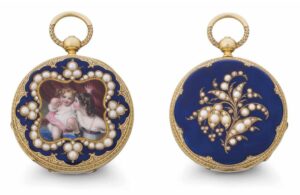
“THE PEARL SET PORTRAIT”
This noteable acquistion was consigned to CHRISTIES by YE OLDE TIMEKEEPERS and was one of the most important pocket watch enamels to hit the global market.
Perhaps one of the earliest known examples of its kind, this enamel portrait of two adolescent girls dates back to circa 1850. Additionally, very rare in the context of Patek Philippe design craftsmanship was the inlaid pearl set into the enaemel case which indicates this piece was madefor the asian market. A unique example and rarity for its time period and especially maker who some 150 years later is still known today to produce some of the nicest and most important enamel scened timepieces.
SOTHEBY’S SALE 0389,
LOT 2086
October, Hong Kong, 2012
SOLD FOR $64,495.00 USD
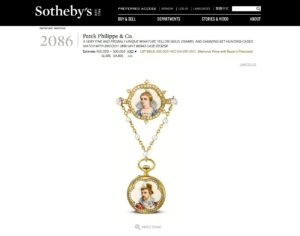
“THE DUKE OF GUISE”
This noteable acquistion was consigned to SOTHEBYS by YE OLDE TIMEKEEPERS and was one of the most important enamel pocket watches t to hit the global market.
Previously unrecorded anywhere in literature, YE OLDE TIMEKEEPERS was delighted to present with SOTHEBYS this rare timepiece discovery. Most important is the enamel painting found on this miniature pocket watch because it was undertaken by a master of the craft, Theodore Z. Zasche. Signed Theodore Z. Zasche to the sitters hat; the artist was a third generation enameller of exceptional quality with his work exhibited in the Geneva Museum of Art. Enameled portraits featuring Henry’s father, Francois de Guise can be found in the Louvre Gallery, Paris and of his brother Charles de Guise in the Victoria & Albert Museun, London. An almost identical portrait watch was made of King Henry II in 1890 and the present example is part of a very special, select collection of 8-10 unique examples featuring French nobility of the 16th century created by Patek Philippe circa 1890. Henry I, Duke of Guise, Prince of Joinville, Count of EU, was born the eldest son of Francis, Duke of Guise on December 31,1550.
Henry succeeded his father as the Duke of Guise in 1563 after his father’s assassination and later became noteable for his controversial love affair with Margaret of France (1553-1615) in 1570 and in 1576 founding the French Catholic League. Margaret of france (1553-1615) was Queen of France during the late 16th century. Margaret was famous for her beauty and sense of style as she was seen as one of the most fashionable women of her time. Her life inspired a variety of stories over the centuries beginning with Shakespeare’s early comedy Love’s Labour’s Lost written during her lifetime, to Alexandre Dumas, 1845 novel La Reine Margot; to a 1994 movie LA Reine Margot. This important extremely rare pendant watch captures the history and relationsihps in the 16the century nearly 200 years later and was created by one of Patek Philippe’s most famous enamel artist.
